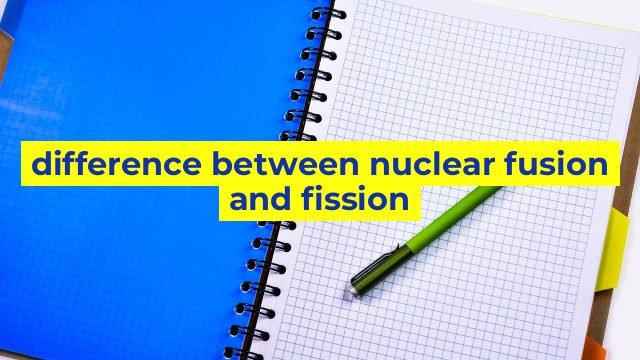The Difference Between Nuclear Fusion and Fission – Explained
Nuclear energy is a form of energy that comes from the atomic nuclei of an element. There are two main types of nuclear energy, namely nuclear fusion and nuclear fission. Although both processes release a considerable amount of energy, there are some critical differences between fusion and fission.
Nuclear Fusion
Nuclear fusion is a process where two light atomic nuclei combine to form a heavier nucleus. The process usually requires high temperatures and pressures to overcome the electrostatic repulsion between the positively charged nuclei. This process is similar to what happens in the sun, where hydrogen atoms combine to form helium. With fusion, the mass of the resulting nucleus is slightly less than the original mass of the two nuclei. This lost mass is released as a significant amount of energy in the form of heat and light.
Nuclear fusion is the most efficient way of producing energy, as it releases a large amount of energy with very little radioactive material. Since the process only involves light elements such as hydrogen, there is no risk of a nuclear explosion or meltdown, unlike nuclear fission. However, scientists have not yet mastered the technology required to harness fusion energy on a large scale, making it currently unfeasible as an energy source.
Nuclear Fission
Nuclear fission is the process of splitting the nucleus of an atom into two or more smaller nuclei. This process produces a large amount of energy in the form of heat, but it also produces radioactive waste material that must be properly stored for thousands of years.
The energy produced by nuclear fission is currently used to generate electricity in nuclear power plants around the world. However, it is also the same process that occurs in the construction of nuclear bombs, making it a potentially dangerous technology when not handled properly.
Conclusion
In conclusion, both nuclear fusion and fission have the potential to produce a significant amount of energy. However, with nuclear fusion, the process is cleaner and safer, making it a more attractive option. On the other hand, nuclear fission has been used as a reliable source of energy for decades, but it comes with its fair share of risks and challenges. Ultimately, the choice between the two will depend on the availability of technology and the environmental, economic, and social implications of each process.
Table difference between nuclear fusion and fission
| Nuclear Fusion | Nuclear Fission | |
|---|---|---|
| Definition | Nuclear fusion is a process where two atomic nuclei combine to form a larger nucleus, releasing an enormous amount of energy in the process. | Nuclear fission is a nuclear reaction in which the nucleus of an atom is split into smaller parts, releasing energy in the process. |
| Type of Reactants | Fusion occurs when light nuclei, such as hydrogen, combine to form heavier nuclei like helium. | Fission occurs when heavy nuclei, such as uranium or plutonium, are split into two or more smaller nuclei. |
| Energy Released | The energy released during nuclear fusion is much greater than the energy released during fission. | The energy released during nuclear fission is less than the energy released during fusion. |
| Occurrence in Nature | Nuclear fusion occurs naturally in the sun and other stars. | Nuclear fission occurs in nature in certain types of radioactive decay but is not as common as fusion. |
| Applications | Fusion has the potential to provide almost unlimited amounts of clean energy. | Fission is currently used to generate electricity in nuclear power plants but produces radioactive waste. |


